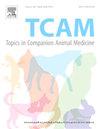豚鼠泌尿生殖道弥散性b细胞淋巴瘤(宫颈)。
IF 1.3
3区 农林科学
Q2 VETERINARY SCIENCES
引用次数: 0
摘要
一个4岁,0.81公斤,雌性完整的美国豚鼠(Cavia porcellus),有一天的肛周肿胀史。体格检查显示身体状况评分为2分(满分9分),腹部肿胀,触诊疼痛,外阴形态异常,肿大,水肿,溃疡,红斑并粘附异物,右乳腺1 × 1 cm坚固肿块。血液学显示明显的淋巴细胞增多和嗜异性增生,生化检查显示白蛋白、碱性磷酸酶和钠升高。x线片和腹部超声显示尾侧腹部肿块效应,整个泌尿生殖道水肿肿大,右乳腺肿块效应,盲肠和胃气胀,膀胱壁明显增厚,可能有尿石和矿化沉积物。由于疾病的严重程度,选择安乐死,并进行组织病理学尸检。肉眼检查发现外阴及周围组织坚硬肿胀,双侧肿块扩张乳腺脂肪垫,腹股沟及下颌淋巴结双侧肿大。组织病理学检查显示单一形态的肿瘤淋巴细胞浸润子宫、阔韧带、外阴、肾脏、膀胱、肺、肝、心脏、脑膜、甲状腺和骨髓。经PAX5免疫组化诊断为弥散性b细胞淋巴瘤。这是首例弥散性b细胞淋巴瘤在豚鼠,主要影响泌尿生殖道。会阴肿大的豚鼠应考虑淋巴瘤作为鉴别诊断。本文章由计算机程序翻译,如有差异,请以英文原文为准。
Disseminated B-cell lymphoma of the urogenital tract in a guinea pig (Cavia porcellus)
A 4-year-old, 0.81 kg, female intact, American guinea pig (Cavia porcellus) was presented for a one-day history of perianal swelling. Physical examination revealed a body condition score of 2 out of 9, a distended abdomen that was painful on palpation, an abnormal vulvar conformation that was enlarged, edematous, ulcerated, and erythematous with adhered foreign material, and a 1 × 1 cm firm mass of the right mammary gland. Hematology revealed a marked lymphocytosis and heterophilia, and a biochemistry panel revealed elevated albumin, alkaline phosphatase, and sodium. Radiographs and abdominal ultrasound showed a caudal abdominal mass effect, edematous enlargement throughout the urogenital tract, a mass effect in the right mammary gland, gas distention of the cecum and stomach, and a markedly thickened urinary bladder wall with probable uroliths and mineralized sediment. Due to the extent of disease, euthanasia was elected and a necropsy with histopathology was performed. On gross examination the vulva and surrounding tissues were firm and swollen, bilateral masses were identified expanding each mammary fat pad, and the inguinal and mandibular lymph nodes were bilaterally enlarged. Histopathologic examination revealed a monomorphic population of neoplastic lymphocytes effacing the uterus, broad ligament, vulva, kidneys, urinary bladder, lung, liver, heart, leptomeninges, thyroid, and bone marrow. The diagnosis was determined to be disseminated B-cell lymphoma via PAX5 immunohistochemistry. This is the first case of disseminated B-cell lymphoma in a guinea pig that predominantly affected the urogenital tract. Lymphoma should be considered as a differential diagnosis in guinea pigs with perineal enlargement.
求助全文
通过发布文献求助,成功后即可免费获取论文全文。
去求助
来源期刊

Topics in companion animal medicine
农林科学-兽医学
CiteScore
2.30
自引率
0.00%
发文量
60
审稿时长
88 days
期刊介绍:
Published quarterly, Topics in Companion Animal Medicine is a peer-reviewed veterinary scientific journal dedicated to providing practitioners with the most recent advances in companion animal medicine. The journal publishes high quality original clinical research focusing on important topics in companion animal medicine.
 求助内容:
求助内容: 应助结果提醒方式:
应助结果提醒方式:


